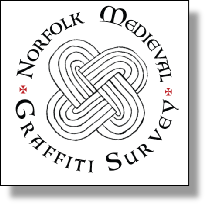









Coats of arms, heraldic elements and shields in general are relatively common finds amongst medieval graffiti. They can vary enormously in quality, from neatly executed full coats of arms, such as that on the east face of the chancel arch at Troston St Mary, to mere scratched outline shapes, such as those found at Swannington. Although we tend to expect well inscribed heraldic graffiti to be identifiable that simply hasn’t been the case – with no inscription being able to be positively identified with any particular family. The reason for this is fairly straightforward. Heraldry relies upon colour for its full meaning to be apparent and the graffiti inscriptions contain no elements of colour. Therefore, even a neatly executed shield, with identifiable elements, but not colour, could potentially have belonged to as many as twenty or more families.
The most notable feature concerning heraldic graffiti is the fact that, of all the graffiti inscriptions found in churches, it appears to be the most likely to be subsequently defaced. In certain churches, such as Bale in North Norfolk, areas that contain several graffiti inscriptions are still clearly visible. However, amongst the many inscriptions it is clearly only those of a heraldic nature that have been defaced. It is thought that this may be because the heraldic graffiti was associated with particular individuals, whilst many of the other inscriptions were devotional in nature. It was therefore easy to strike at an individual or family by destroying their coat of arms, whilst less likely that devotional imagery would be attacked, thereby bringing down the wrath of God.



















